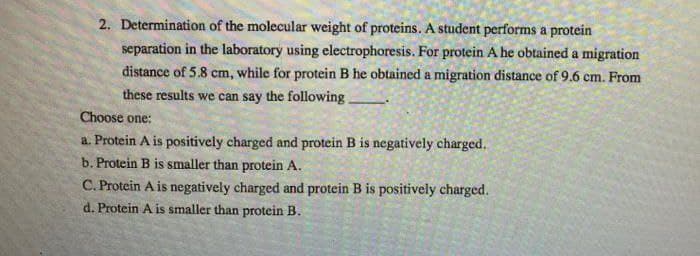2. Determination of the molecular weight of proteins. A student performs a protein separation in the laboratory using electrophoresis. For protein A he obtained a migration distance of 5.8 cm, while for protein B he obtained a migration distance of 9.6 cm. From these results we can say the following Choose one: a. Protein A is positively charged and protein B is negatively charged. b. Protein B is smaller than protein A. C. Protein A is negatively charged and protein B is positively charged. d. Protein A is smaller than protein B.
2. Determination of the molecular weight of proteins. A student performs a protein separation in the laboratory using electrophoresis. For protein A he obtained a migration distance of 5.8 cm, while for protein B he obtained a migration distance of 9.6 cm. From these results we can say the following Choose one: a. Protein A is positively charged and protein B is negatively charged. b. Protein B is smaller than protein A. C. Protein A is negatively charged and protein B is positively charged. d. Protein A is smaller than protein B.
Chemistry: Matter and Change
1st Edition
ISBN:9780078746376
Author:Dinah Zike, Laurel Dingrando, Nicholas Hainen, Cheryl Wistrom
Publisher:Dinah Zike, Laurel Dingrando, Nicholas Hainen, Cheryl Wistrom
Chapter14: Mixtures And Solutions
Section14.1: Types Of Mixtures
Problem 7SSC
Related questions
Question

Transcribed Image Text:2. Determination of the molecular weight of proteins. A student performs a protein
separation in the laboratory using electrophoresis. For protein A he obtained a migration
distance of 5.8 cm, while for protein B he obtained a migration distance of 9.6 cm. From
these results we can say the following.
Choose one:
a. Protein A is positively charged and protein B is negatively charged.
b. Protein B is smaller than protein A.
C. Protein A is negatively charged and protein B is positively charged.
d. Protein A is smaller than protein B.
Expert Solution
This question has been solved!
Explore an expertly crafted, step-by-step solution for a thorough understanding of key concepts.
Step by step
Solved in 2 steps with 2 images

Knowledge Booster
Learn more about
Need a deep-dive on the concept behind this application? Look no further. Learn more about this topic, chemistry and related others by exploring similar questions and additional content below.Recommended textbooks for you

Chemistry: Matter and Change
Chemistry
ISBN:
9780078746376
Author:
Dinah Zike, Laurel Dingrando, Nicholas Hainen, Cheryl Wistrom
Publisher:
Glencoe/McGraw-Hill School Pub Co

Chemistry: Matter and Change
Chemistry
ISBN:
9780078746376
Author:
Dinah Zike, Laurel Dingrando, Nicholas Hainen, Cheryl Wistrom
Publisher:
Glencoe/McGraw-Hill School Pub Co